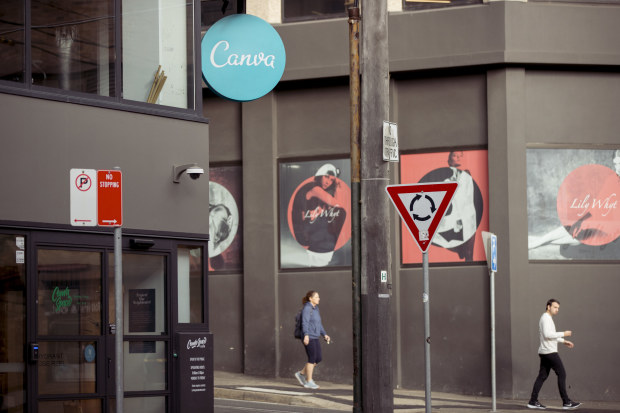Three-quarters of its employees tended to be ranked as having had a “great year”, with about 20 per cent getting an “exceptional year” that could come with a promotion. Just 5 per cent of its more than 10,000 employees were effectively told to improve with an “off year” rating.
The new system, which is being rolled out to assess the financial year just passed, has less boosterish names reflecting Atlassian’s position as a much larger company that needs to make finer distinctions among staff. The Australian Financial Review has seen internal data with expected percentages of staff by ranking.
Canva in Sydney’s Surry Hills has been home to an envied culture, which is getting tougher as the market gets more bearish. Dominic Lorrimer
About 15 per cent of staff will be told they “greatly exceeded expectations” and 30 per cent will have “exceeded expectations”, putting more employees above average than the old system. Forty-five per cent will be ranked as having “met expectations”.
Twice as many people as before will be told they need to improve, with 6 per cent expected to be advised they “met most expectations” and 4 per cent facing a blunt “did not meet expectations”.
Those in the higher tiers will get substantially more financial rewards, people in the middle will get their full contracted bonus, and people on the lowest grade risk receiving no bonus or share grant for that year at all.
Fears for tiers
At Canva, meanwhile, senior executives have developed a five-tier performance ranking, whereby employees are put into categories titled Missing, Approaching, Thriving, Excelling or Redefining.
Those on the lower rungs are put into internal coaching programs over several months, tracked by management and then cut from the organisation if they are still considered to be underperformers.
Both companies face perhaps the toughest operating environment in their histories, and have seen their valuations plummet from their COVID-fuelled peaks.
They came to embody the tech industry cliché of perk-filled work life, and friendly internal cultures that can look almost cult-like to outsiders.
In a well-publicised war for scarce tech talent, they adorned their offices with rock climbing walls, offered free drinks and meals, and hosted frequent staff parties.
‘Uncharacteristic move’
“It’s a really uncharacteristic move by Atlassian,” said one employee of the changed employee appraisals.
“They haven’t done anything like this before. It’s been a very chill company, vibing out, playing as a team, [and] now it’s becoming similar to Facebook, Google, Microsoft.”
Staff members who requested anonymity because Atlassian doesn’t allow employees to talk publicly, said they were delighted by the change. They predicted it would stop highly paid colleagues from slacking off work early in the afternoon and encourage them to help Atlassian rival the truly massive US technology firms it competes against.
“The fact that people were doing two hours of work and socialising all day was a zero interest rate phenomenon,” said the employee, who noted there were many other hard-charging Atlassian workers.
Other Atlassian staff have been less impressed, using internal online noticeboards to express their fears that the company’s collaborative culture was at risk. It still has a separate reward scheme for helpful co-workers.
Under the changes, teams of more than 150 people at Atlassian will be expected to adhere to the ranking curve, though they can deviate if they have a good reason.
Atlassian’s global human resources boss Avani Prabhakar.
Atlassian’s global human resources boss Avani Prabhakar linked the changes to the company’s growth.
“Moving to a more differentiated system not only means better rewarding a larger group of people for exceptional performance, but it further clarifies the high bar we hold at Atlassian for the important work we do for our customers,” Ms Prabhakar said.
Atlassian’s share price is up by about a third this calendar year to $US167, but is still down more than 60 per cent from its COVID-19 stimulus and lockdown-fuelled highs of late 2021.
It made about 5 per cent of its workforce redundant earlier this year, just months after a much-publicised hiring spree.
No longer thriving
At Canva, the situation is different, with the private company resisting the urge to make lay-offs and adding employees as the firm looks to expand in the United States.
However, staff members told The Financial Review the number of people being “performance managed-out” of the organisation has noticeably increased.
One Canva employee described the performance management process as being like a scene in the George Clooney movie Up in the Air, where corporate downsizers travel the country, sacking workers with cut-throat efficiency.
They said staff met with senior managers to discuss how they had fallen down the categories, with an HR representative then reading out the next steps from a script.
These steps would involve having their responsibilities changed and progress regularly monitored. Canva disputes this characterisation of its methods, particularly the use of a script, insisting that staff were only let go after regular feedback and support.
The number of people leaving through the performance management process has recently increased, but the firm had concurrently increased its headcount from 2700 to 3700 in the past year.
Performance management programs that regularly cut underperforming employees have become popular among Silicon Valley tech giants, borrowing HR practices like “stack ranking”, pioneered by General Electric CEO Jack Welch in the 1980s.
At Amazon, founder Jeff Bezos built an HR program that puts about 10 to 15 per cent of its employees every year through a “PIP” (performance improvement plan). Employees rarely survive the multi-month PIP process, meaning Amazon cuts about a tenth of its headcount annually.
>>> Read full article>>>
Copyright for syndicated content belongs to the linked Source : Australian Financial Review – https://www.afr.com/technology/atlassian-and-canva-turn-screws-on-staff-to-survive-the-downturn-20230630-p5dkx0

































